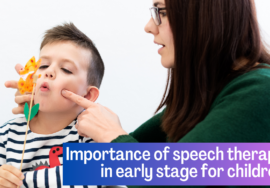
Unmasking 6 Myths about Speech Disorders in Children
Speech development plays a crucial role in a child’s overall growth & communication skills. Unfortunately, there are several myths and misinformation around speech disorders in children that can hinder their progress. It’s crucial to separate facts from fiction and hence in this blog, we’ll address six common myths about speech disorders and present the real facts to help parents understand and support their children effectively.
Myth 1: Speech disorders are just a phase that children will grow out of.
One common misconception is that speech disorders are simply a phase that children will naturally overcome. However, the reality is quite different. Without proper intervention, speech disorders often persist and can create difficulties in various aspects of a child’s life. Early intervention is crucial because it allows speech therapists to use effective techniques tailored to each child’s specific needs.
Myth 2: Speaking two languages (bilingualism) can make it difficult for children to develop their speech properly.
Another prevailing myth suggests that bilingualism hinders speech development in children. But research indicates that bilingualism actually benefits cognitive development and does not cause speech disorders. It is important to clarify this misconception and support bilingual children with speech disorders by providing appropriate strategies & therapy.
Myth 3: Speech disorders only affect a child’s ability to speak.
Contrary to popular belief, speech disorders extend beyond a child’s ability to speak. They often impact communication as a whole, including understanding and expressing thoughts, emotions & social interactions. It is essential to recognize the broader impact of speech disorders and adopt a holistic approach to therapy that addresses these interconnected aspects.
Myth 4: Boys are more likely to have speech disorders than girls.
Gender bias plays a role in perpetuating the myth that boys are more prone to speech disorders. But actually, speech disorders affect both boys and girls equally. Societal factors can influence the disparities observed, emphasizing the importance of unbiased assessment and individualized therapy for all children.
Myth 5: Speech disorders are caused by parenting or environmental factors.
Blaming parents or environmental factors for a child’s speech disorder is another misguided myth. While genetics and biology play significant roles, environmental factors may contribute as well. It is essential to adopt a supportive and collaborative approach with parents, providing them with resources and guidance rather than placing blame.
Myth 6: Speech therapy is not effective for treating speech disorders in children.
Lastly, skepticism surrounding the effectiveness of speech therapy is a prevalent myth. However, research consistently demonstrates the efficacy of speech therapy in treating speech disorders. Success stories and case studies further illustrate the positive outcomes achieved through individualized therapy plans and ongoing support.
Clearing this air of misconceptions, providing personalized therapy & promoting early intervention are the keys to unlocking the potential of children with speech disorders.
ClearSound stands as a leading speech therapy clinic in Delhi, committed to providing high-quality services and debunking common myths surrounding speech disorders in children. Our experienced team of speech therapists is dedicated to delivering personalized therapy plans that address each child’s unique needs. We understand the importance of early intervention and the positive impact it can have on a child’s speech and language development. With affordable speech therapy costs, ClearSound ensures that access to quality therapy is within reach for families.
Enabling children with speech disorders to communicate & thrive…


